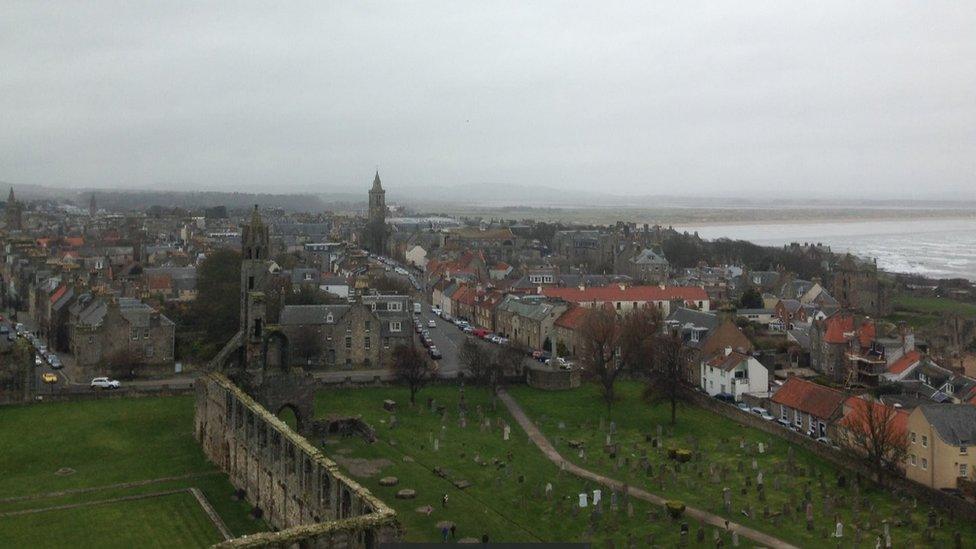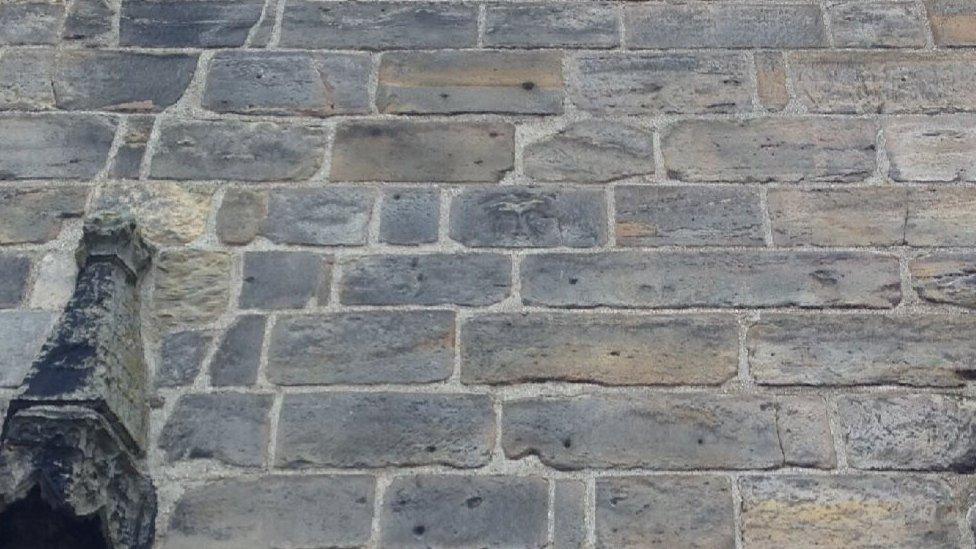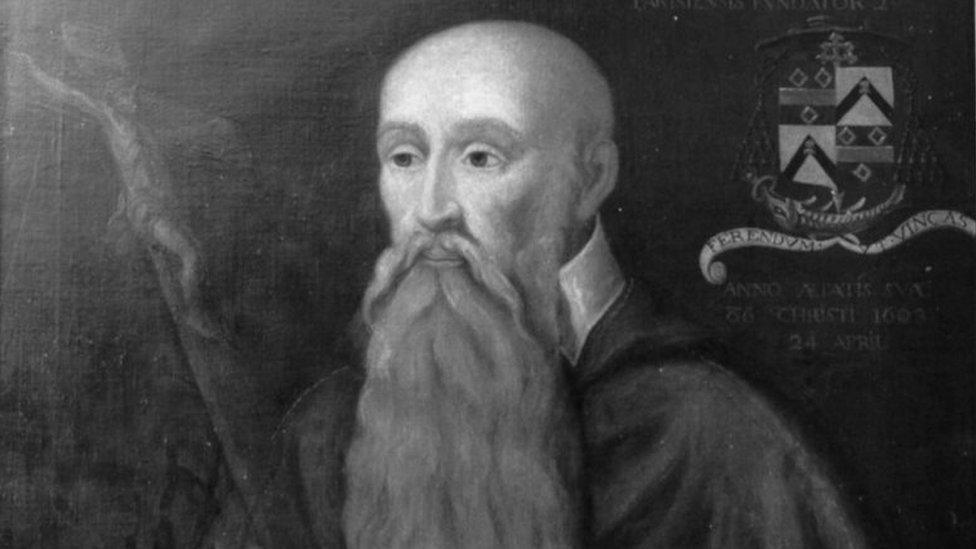Patrick Hamilton: Recreating the trial of the first Scottish martyr
- Published

Patrick Hamilton was tried and executed on the same day in 1528
Almost 500 years ago a young theologian was burned at the stake for daring to challenge the Roman Catholic church. Now his trial - which sparked a national outcry and was a key trigger of the Scottish Reformation - is being recreated and reassessed at one of the institutions which helped execute him.
Patrick Hamilton's agonising death at the stake was supposed to scare critics of the Roman Catholic church in Scotland into silence.
Instead, the flames that consumed him over six excruciating hours kindled the country's religious reformation.
Hamilton, a preacher and member of the faculty of arts at the University of St Andrews in Fife, was killed on 29 February 1528, in the centre of the town after he spoke out against what he saw as corruption in the church in Scotland.
His trial revolved around 13 thoughts he had expressed in the preceding months which challenged church "hypocrisy" and called for the Bible, then only copied into Latin, to be more available to common people.
"Here we have a young man saying the church has become too powerful, corrupt and hypocritical," says William Eves, a research fellow at the University of St Andrews' School of History.
"Influenced by the work of Martin Luther in Germany, Hamilton wanted a simpler form of worship which focused more closely on scripture than on the rituals of the Roman Church."

Who was Patrick Hamilton?
Hamilton was born into a rich and noble Scottish family - his mother was the granddaughter of James II, making Hamilton a distant cousin of the 15-year-old James V.
As a younger son he was destined for a career in the church and in 1517 he was made titular abbot of Fearn Abbey.
In 1518 he went to study at the University of Paris where it is believed he first came across the preachings of Martin Luther, a German theologian who essentially founded Protestantism.
He returned to Scotland in 1523 and a year later joined the faculty of arts at the University of St Andrews.
Hamilton's preachings soon came to the attention of the Archbishop of St Andrews and the university's chancellor James Beaton who ordered the inquiry which led to his trial and execution.
He was 24 years old when he died.

One of the reasons Hamilton's death had such resonance was where it took place.
St Andrews was the centre of Catholicism in Scotland having reputedly acquired the relics of the town's namesake in the 4th Century, believed to be the apostle's arm, three fingers, kneecap and a tooth.
The Archbishop of St Andrews was a powerful position that came complete with a formidable castle on the cliffs and great cathedral from which the town's streets radiated.

The cathedral of St Andrews was the centre of Catholicism in Scotland
The university, more famous in recent years for being the meeting place of Prince William and Kate Middleton, was founded in 1413 and, like the church, was an important institution in Scotland.
But also like the church, it did not come out well from the trial and death of Patrick Hamilton.
Not only did the university refuse to help its student against the charges brought by the church, it also helped the accusers compile evidence of his misdeeds.

Hamilton's heresy
Patrick Hamilton's trial was based around 13 comments he was said to have made which the church considered heretical.
These included his beliefs that the church's confession service, which cleared people of their sins, was "devilish" and unable to actually provide penance, and that "corruption of sin" remains in children after their baptism.
He was also accused of saying "no obedience is due" to the laws and rituals carried out by the church as they were created by men, not passed down from the Bible.
The church was also angered by his claims that the sacraments - ceremonies intended to bestow spiritual grace - were ineffectual and those who had put their faith in them before their deaths died in an "evil and imperfect faith and are buried in hell".
Hamilton also said tithes - a form of tax - should not be paid to the church and the Bible, which was the word of God, should be translated into English so more people could read it rather than having to rely on priests reading the Latin.

"Leading figures in the university helped convict Hamilton," says Dr Bess Rhodes, an expert in Scottish history.
"Rather than defending free speech St Andrews' academics saw their role as upholding and enforcing the teachings of the Catholic Church.
"As for the church, their handling of Hamilton was a serious misjudgement.
"Hamilton's death made him a martyr and gave the Protestant movement in Scotland a symbol to rally behind.
"Many of the men who prosecuted Hamilton were probably sincere in their beliefs, but their handling of this incident turned into a public relations disaster for the Catholic Church in St Andrews."

Patrick Hamilton's initials have been laid out in the cobbles at the spot where he died
On 6 May this year the university will recreate the trial, external which, though it was held 488 years ago, still has relevance today, says Mr Eves.
He says: "Freedom of speech, the way evidence is gathered, the speed with which justice should be done and the potentially inflammatory effects of high-profile trials, all of which were of central importance to the trial of Hamilton, continue to be debated today."
Hamilton's death shocked many and inspired others to join the Protestant movement, not least because the details of his last few hours made for an unpleasant account.

The streets of St Andrews radiated from the cathedral. The tower of St Salvator's church outside which Patrick Hamilton was executed can be seen in the centre of the picture further up the street from the cathedral's ruins
A strong easterly wind blew through North Street preventing the fire at his feet from properly taking hold.
So it was a long, slow and painful process.
Gunpowder which had been laid to hasten the blaze merely scorched and burned Hamilton's head and hands.

The image of Hamilton's face is said to have been burned into a brick at St Salvator's church overlooking the spot of his execution
But he remained resolute, refusing the pleas of onlookers to repent.
As the end neared a voice in the crowd called for Hamilton to give a sign if he still had faith in his teachings.
Hamilton raised three fingers and held them high until he died.
Afterwards, one man, John Lindsay, reportedly wrote to Archbishop Beaton: "If you burn any more you will utterly destroy yourselves.
"If you will burn them let them be burnt in deep cellars, for the smoke of Patrick Hamilton has infected as many as it blew upon."

Archbishop James Beaton was warned Hamilton's death had inspired others to oppose the church
As well as being a subject for debate among its scholars, Hamilton's death has also left a physical mark on St Andrews.
His initials are depicted in the cobbles where he met his end while a face purported to be his was said to have melted into a stone on nearby St Salvator's church tower.
According to university lore, any student walking over the cobbles will fail their exams unless they run into the North Sea at dawn on first day of May.
There is also a memorial to Hamilton and other martyrs who followed his lead and were killed by the church.
Talking Law will be held at the Byre Theatre on 6 May with a dramatisation of Hamilton's trial followed by a debate with panellists barrister Harry Potter, sheriff Lorna Drummond and former Tayside Police assistant chief constable Angela Wilson. Tickets are free and the project is funded by the Arts and Humanities Research Council.